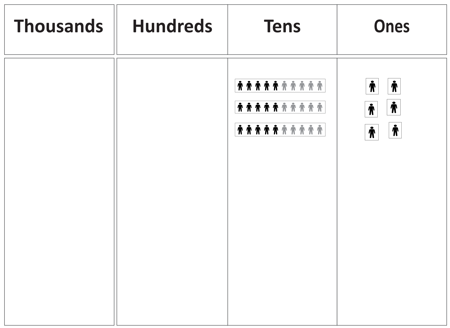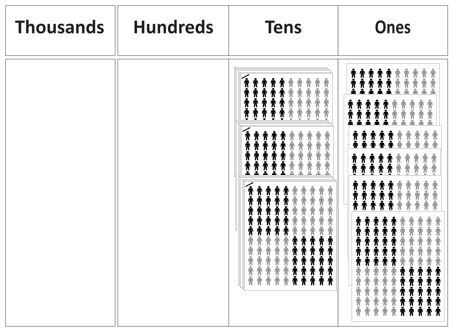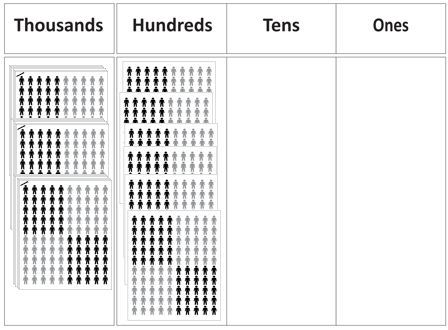Purpose
The purpose of this activity is to support students to anticipate the result of multiplying a whole number by 100.
Achievement Objectives
NA3-1: Use a range of additive and simple multiplicative strategies with whole numbers, fractions, decimals, and percentages.
NA3-2: Know basic multiplication and division facts.
NA3-4: Know how many tenths, tens, hundreds, and thousands are in whole numbers.
Required Resource Materials
- Place value people (make thousands from ten 100-squares stapled together)
- Place value board (page 1)
- Calculator
Activity
- Pose problems that involve '100 times more’, with two-digit numbers, such as:
Make the number 36 with place value blocks.
What number have I made?
If I get 100 times more cubes than what I have now, how many cubes will I have?
Let students predict the result.
- Discuss what each unit becomes if it is made ten times its size. You may need to illustrate that 100 ones form 100 (10 x 10 square) and 100 tens form 1000 (ten hundred squares stapled together). Exchange each single person (one) for a square of one hundred, and each ten strip for a block or 1000. Move the squares and stacks into the hundreds and thousands columns.
What number is 100 times 36?
What equation can we write for this problem?
Key in 100 x 36 = 3600 on the calculator and record the equation.

- Let the students anticipate, and then solve, similar problems with materials. Good examples are shown below. Ensure students express the relevant equations, using a suitable means of expression (e.g. written, verbal), as they work. Also consider allowing students to work in groupings that will encourage peer scaffolding and extension. Some students might benefit from working independently, whilst others might need further support from the teacher.
What number is 100 times 24
What number is 100 times 57?
Next steps
- Progress from using materials to anticipating the results using only equations and words, and then patterns. Calculators can be used to confirm predictions. For example:
- 100 x 4 = 400
- 100 x 45 = 4500
- 100 x 456 = 45 600
- 1000 x 4567 = 456 700
- Discuss what happens to the place values of different numbers as they are multiplied by 100:
- Each one becomes worth 100.
- Every ten becomes worth 1000.
- Every 100 becomes worth 10 000.
- Provide problems framed in real-life, meaningful contexts in which multiplication by 100 can be used.
- You have seventy-seven $100 notes. How much money do you have?
- There are 100 golf balls in a tray. How many golf balls are in 25 trays?
- Each person eats about 240 grams of meat at the hāngī. How many grams do 100 people eat?
Add to plan
Level Three